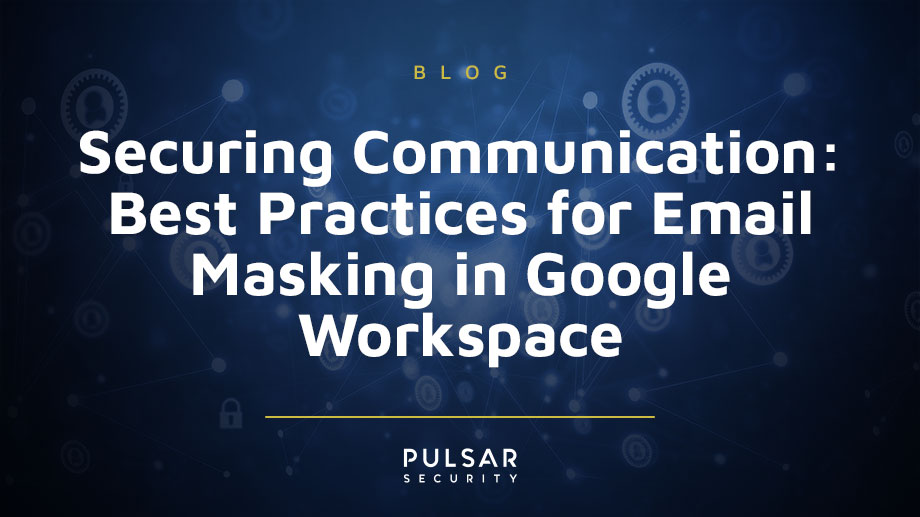Securing Communication: Best Practices for Email Masking in Google Workspace
PART TWO OF THREE
The rising trend where businesses favor fewer enterprise messaging platforms has boosted Google Workspace's popularity. Unfortunately, this surge in adoption has also made it a more attractive target for cybercriminals. Furthermore, studies reveal that 11% of emails, even after passing Gmail's basic security checks, still contain spam and malware. Therefore, organizations must seek top-tier, independent email security solutions to ensure genuine cyber resilience within the Google Workspace environment. Chief among them is implementing email masking solutions.
Understanding Email Masking in your Google Workspace
The most coveted information for cybercriminals is not your social security number or credit card details; it's your login credentials. These details give hackers access to your digital life. Surprisingly, 63% of data breaches stem from seemingly insignificant events, like the theft or compromise of login credentials.
Moreover, more than 500 million phishing statistics have been reported in 2023, highlighting the growing threat. Therefore, vigilance is more important than ever. Thankfully, you can safeguard your personal information and ensure email security through a technique known as email masking.
How does Email Masking work?
Email masking means replacing an actual email address with a generic and unidentifiable "masked" one. It helps protect the privacy of both the sender and the recipient. In particular, users get email aliases to hide their actual contact information.
In essence, masked emails enable users to send or receive email messages without revealing their actual email addresses, safeguarding personal data and identity. It might sound complex, but it's pretty straightforward. When you mask your email address, it lets you use anonymous email addresses instantly whenever a new account requires your email. This method adds an extra layer of identity protection with minimal risk and hassle.
Specifically, email masking assigns you an address like "newcarsite@gmail.com." As a result, this is the email address that appears when a website requests your email, effectively hiding your information from potential fraudsters and identity thieves. Given the numerous email security threats, including phishing attacks, financial scams, and data breaches, email masking clearly emerges as a sensible choice for protecting your online presence.
Email masking is a subset of data masking, a technique that safeguards sensitive data from unauthorized access or abuse. While many companies offer data masking for password protection, it often falls short in shielding your email information. Therefore, it's essential to use a service that provides comprehensive protection against the threats and risks that come with sharing your email online.
Leveraging Email Masking to enhance the security of your Google workspace
Indeed, email masking is a crucial part of data masking. It is a broader practice that transforms sensitive information, including names, credit card information, surnames, and social security data, to conceal their true identity.
Email masking enhances the security of your Google Workspace by creating a fictitious or authentic-looking version of the organization's email address. As a result, it hides the actual email address and replaces it with a fabricated one, improving the privacy of business emails. Also, email masking provides several advantages for safeguarding both the organization and its clientele. Some of these benefits include:
- Identity Theft Protection: Google Workspace users often engage in online activities using email accounts that can be vulnerable to online identity theft. This could result in fraudulent activities and unauthorized access to sensitive systems. Email masking effectively thwarts these threats by concealing actual email addresses and safeguarding user identities and privacy within Google Workspace.
- Breach Protection: Google Workspace users, including employees and customers, often provide their email addresses, exposing sensitive information. If the websites they interact with are compromised, the entire organization could be at risk of data breaches. Email masking ensures any data acquired by potential attackers is rendered useless, reducing the risk of data breaches.
- Spam and Phishing Protection: In an era of increasing spam and phishing threats, email masking serves as a robust defense. Each masked email address generated within Google Workspace is unique and isolated, reducing the risk of information leakage and adding an extra layer of protection against email-based threats. This is especially important as spam and phishing attacks have seen a continued increase.
- Safe Testing Environment: Google Workspace administrators often need to conduct testing and quality assurance processes. With email masking, they can establish a secure testing environment without disrupting existing databases or accidentally sending spam emails to real customer accounts, ensuring a controlled and secure testing process.
Top Benefits of Email Masking in Google workspace
1. Reduce the spam messages reaching your inbox
Email masking serves as the connection between the sender and your actual email address, making it easier to block or ignore emails sent to your masked address when you don't want to engage. Additionally, it provides you with the option to redirect all your masked emails to your regular email address.
This means you gain access to a dedicated masked email inbox, allowing you to read, respond, and manage forwarding preferences effortlessly. Moreover, you can block unwanted senders without their knowledge. No more requests to unsubscribe or fill out feedback forms when you no longer wish to receive messages.
2. Reduce the risk of a breach.
As data breaches demonstrate, businesses, regardless of their size, remain susceptible to cyberattacks. The more companies you trust with your email, the higher the risk of exposing your data to malicious actors.
For instance, in 2021, LinkedIn experienced a massive breach affecting 700 million users. The culprits collected data through scraping, and all personal and sensitive information was offered for sale on the dark web.
One notable advantage of using email masking is that it reduces the chances of your data being compromised in the event of a company's data breach. Thus, consider using a masked, anonymous email to strengthen your security measures.
3. Protect against cyberattacks
A significant majority, around 65% of hackers, rely on spear-phishing emails as their primary method to infiltrate an organization and launch more significant attacks. However, using an anonymous email can impede their ability to uncover your actual email address, making it more difficult for them to launch an attack.
In this case, protect yourself from phishing and various other cyber threats by utilizing an advanced email masking service. With email masking, you can quickly create a concealed email to safeguard your sensitive information at every interaction point.
How to configuer Email Masking in Goggle Workspace
- Step 1: Access Google Workspace Admin Console. Log in to your Google Workspace admin console using your administrator credentials. You can do this by visiting https://admin.google.com and signing in.
- Step 2: Navigate to Users. In the admin console, go to the "Users" section. This is where you can manage the email addresses and aliases for your organization.
- Step 3: Select the User or Group. Choose the user or group for which you want to set up email masking.
- Step 4: Edit the User or Group. Click on the user or group that you want to edit to access their settings.
- Step 5: Edit Email Aliases Scroll down to the "Email aliases" or "Email addresses" section, and click the "Add an alias" or "Add an email alias" option.
- Step 6: Create the Alias. Enter the alias or masked email address that you want to use. This can be a different email address that you want to use as a mask for the original email address.
- Step 7: Verify Ownership Google Workspace will ask you to verify ownership of the alias. You'll need to confirm that you have the necessary permissions to use this alias, which often involves confirming the alias by clicking a link sent to that alias's inbox.
- Step 8: Save Changes Once the alias is verified, save your changes. The alias will now be associated with the user or group.
- Step 9: Send Emails Using the Alias Users can now send emails using the alias (masked email address). When composing an email, they can select the alias from the "From" field.
- Step 10: Incoming Emails Emails sent to the alias will be delivered to the primary email address associated with the user or group. There is no need to configure anything for incoming emails; Google Workspace handles this automatically.
- Step 11: Test the Alias It's a good practice to test the alias to ensure it's working as expected. Send and receive test emails to and from the alias to make sure everything is functioning correctly.
- Step 12: Manage Alias Settings. You can return to the user or group settings to manage or remove aliases at any time.
That's it! You've successfully set up email masking in Google Workspace. Users can now use the alias as a masked email address to protect their primary email address while sending and receiving emails.
Overcome challenges with expert assistance
Users often require the services of an expert or a security firm to set up email masking in Google Workspace correctly because it involves configuring sensitive security features and ensuring data privacy. Additionally, properly implementing email masking demands a deep understanding of Google Workspace's administrative settings and access controls. Moreover, it necessitates an awareness of potential security vulnerabilities and best practices to mitigate them.
Security experts can navigate the complexities of user permissions, domain settings, and verification processes. They ensure that email masking is effective at concealing primary email addresses and robust in safeguarding against unauthorized access or misuse. Consequently, their involvement is crucial for a secure and compliant email masking setup.
COMING SOON - PART THREE OF THREE:
Securing Local Infrastructure: A Guide to Email Masking in On-Premises Exchange

Corey Belanger
Corey is a Security Consultant and leads QA of product development, using his expertise in these dual roles to more effectively test and secure applications, whether while building enterprise applications or while performing penetration tests and vulnerability assessments for customers. An Army veteran with a tour of duty in Afghanistan, Corey has built a post-military career in security while earning Network+, Security+, GIAC Certified Incident Handler, GIAC Python Coder, GIAC Web App Penetration Testing, and GIAC Penetration Tester certifications. Corey is also a BsidesNH organizer and founding member of TechRamp, avenues which he uses to help others build their skills for careers in security and technology. Fun Fact: When not manning a terminal or watching the Bruins, Corey can often be found snowboarding or riding his motorcycle.




